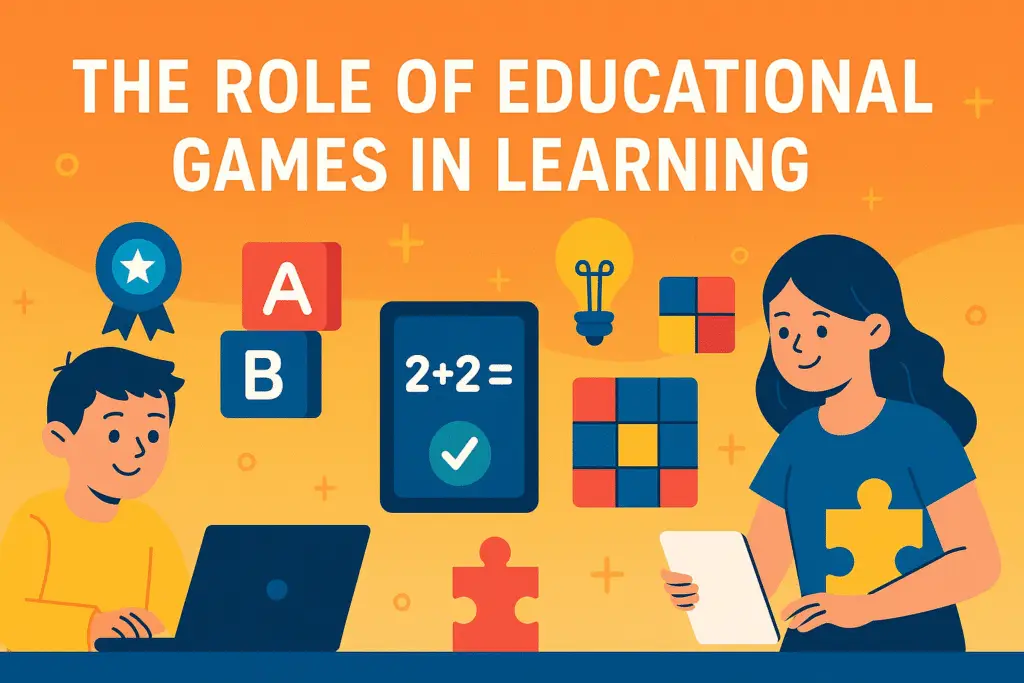Introduction
“Explore how educational games play a vital role in learning by enhancing cognitive skills, creativity, and student engagement through interactive play.”
Traditional education often leans heavily on lectures, textbooks, and repetition. While these methods work for many,

they can struggle to engage learners who have shorter attention spans, diverse learning styles, or who need more interactive reinforcement.
In today’s digital age, educational games are stepping into that gap — offering a bridge between fun and knowledge. When designed well, they become powerful tools to boost cognitive skills, engagement, motivation, and curiosity.
At Aklic, we believe learning doesn’t have to be boring. Through browser-based games, we’re making education simple, interactive, and exciting—accessible anywhere at any time.
A Brief History: From Flash Cards to Gamified Apps
The idea of learning through play isn’t new. Early learning tools included flash cards, board games, and educational TV shows. With the computer revolution, the CD-ROM era introduced scholars to titles like Math Blaster, Reader Rabbit, JumpStart, which mixed learning with adventure.
Then came online educational games, often built with Flash. Flash had limitations: browser compatibility, security issues, and eventually being deprecated. The shift to HTML5, JavaScript, WebGL, and now WebAssembly changed everything — games are more responsive, more secure, and run easily in modern browsers without installing anything special.
Why Educational Games Actually Work (Science-Backed)
Educational games are more than just fun; they align with how the brain learns best. Here’s what research shows:
Active Engagement: Interactive gameplay forces decision-making, exploration, and experimentation. Studies (e.g., in Journal of Educational Psychology) show active involvement increases retention by up to 75%.
Instant Feedback & Learning Loops: When students get immediate feedback (right or wrong), they can correct mistakes, learn from them, and try again. This loop improves understanding and promotes mastery.
Motivation Through Rewards: Points, badges, levels, leaderboards — all provide motivation. Gamification research (e.g. findings by the University of Colorado) shows this increases time spent on task and enjoyment.
Safe Failure Environments: Games allow learners to try, fail, and try again without high stakes. Mistakes are part of the learning journey.
Multisensory Learning: Combining visuals, sound, motion engages more senses so memory and recall are stronger.
Real-World Examples & Case Studies
To illustrate, here are some examples of educational games making a difference:
CoolMathGames: Offers age-appropriate math puzzles, logic games, and brain teasers. Widely used in classrooms for early grade reinforcement.
Khan Academy (browser section): While primarily video/text based, includes interactive quizzes and challenges.
Duolingo: Though popular on mobile, its browser version also helps learners with bite-sized language lessons, using game elements like streaks and rewards to motivate.
ABCmouse.com: Focuses on early childhood learning — letters, phonics, colors, numbers — often used by parents before formal schooling begins.
These examples show that educational games are not niche—they are used globally, across many age groups.
Educational Games at Aklic: Learning by Doing
At Aklic, we design browser-friendly games with simplicity and educational value in mind. Our offerings:
Math Games : addition, subtraction, patterns, logic problems.
Alphabet & Language Games : letter recognition, phonics, beginner word building.
Puzzle & Memory Games : boosting attention, memory, and concentration.
Mini Learning Games : focused topics like counting, shapes, vocabulary. These are great for short study sessions or revision.
Each game is optimized for both desktop and mobile, ensuring you can learn whether you’re on a computer, tablet, or phone.
Real-Life Applications: Where Educational Games Shine
Educational games are beneficial in many contexts beyond classrooms:
At Home: Parents use them to reinforce lessons or introduce new concepts before school starts. For example, a child struggling with multiplication might use a fun game to practice before returning to class.
In Classrooms: Teachers can use games as warm-ups, or for remediation. A number of studies show increased engagement and improved test scores when games are integrated into lesson plans.
Special Education: Games can adapt to different learning speeds and styles, making them especially useful for learners with ADHD, dyslexia, or other learning differences.
Self-Learning / Adult Learning: Adults learning a language, brushing up on skills, or exploring new fields (e.g. logic puzzles, typing, memory games) benefit from the low pressure, flexible environment games provide.
Challenges & Criticisms, And How To Overcome Them
Even though educational games have many benefits, there are also challenges:
Quality Variation: Not all educational games are well designed. Some may emphasize entertainment over learning. Solution: Look for games designed with pedagogical goals, good feedback, and evidence of learning outcomes.
Screen Time Concerns: Excessive time in front of screens is a worry. Solution: Encourage balanced use short sessions, educational value, with breaks.
Curriculum Alignment: Many games don’t align with curriculum standards, so teachers may hesitate to use them. Solution: Provide games that map to curriculum outcomes, or allow teacher customization.
Access & Equity: While browser games don’t need installs, access to devices and reliable internet can still be a barrier. Solution: Design offline-friendly or low-bandwidth games; partner with schools; optimize for low-end devices.
The Future of Educational Games
What’s next in this space? Several exciting trends are shaping the journey forward:
AI-Powered Learning Paths: Games that adapt in real time to each learner’s strengths, weaknesses, and speed.
Collaborative Multiplayer Learning: Students solving tasks together in virtual worlds, encouraging communication, teamwork, and shared problem solving.
Neuroscience-Based Design: Using research about how the brain works (spacing effect, interleaving, memory consolidation) to structure game levels and challenges.
Immersive Technologies (VR/AR/WebXR): Imagine exploring historical places, anatomy, or science labs in virtual space all from your browser.
Global Learning Platforms: Games that enable cross-cultural learning, competitions, and cultural exchange.
FAQs About Educational Games
1) What age groups benefit most?
All age groups can benefit, but early childhood and elementary levels see the biggest gains from interactive games. Older students benefit in specific subjects like language, logic, and STEM when games supplement traditional methods.
2) Are educational games expensive to produce?
They can be, especially high-quality ones. But lightweight browser games with focused scope (like Aklic’s offerings) can be done relatively cheaply, especially with free or open-source tools.
3) How do I pick a high-quality educational game?
Check for clear learning goals, good feedback systems, evidence (studies or reviews), balanced challenge, and minimal distractions.
4) Can they replace traditional education?
Not entirely. They work best as supplements, not replacements. They help reinforce, motivate, and engage—but full learning still depends on quality teaching, practice, and reflection.
Final Thoughts: Learning That Lasts
Educational games are transforming how we learn. They turn learning into an experience—one that teaches, entertains, and inspires. Through play, learners of all ages build skills, stay motivated, and enjoy the journey.
At Aklic, we’re committed to creating educational games that matter—ones that are fun, meaningful, and accessible. Because at the end of the day, the best learning is the kind that lasts.
External Links & References
Journal of Educational Psychology — look for studies about gamified learning.
Khan Academy — example of web learning tools.
CoolMathGames — logic & math games.
Duolingo — game mechanics in language learning.
